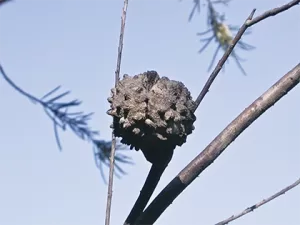By Lachlan Turner
When venturing along walking tracks in our local bushland it is always a pleasant surprise to come across an unexpected wildflower. One of the more noticeable and abundant varieties during cooler months would be the Silky Needle Bush (Hakea sericea).
This attractive spreading, open shrub may grow up to 3m high in favourable conditions. It can be found in both open forest and scrubby heathlands which have sandy or clay soils.
Depending upon its habitat, flowering may commence in June and continue into September.

The narrow, fairly rigid leaves are about 50mm long, right-angled to the branch, having a sharp tip at the end. Hence the word “Needle” is in its name. The other word in its common name appears to be derived from the silky hairs that are present on new growth.
Delicately formed white flowers are mostly clustered towards the ends of reddish-brown branches. These flowers possess a mild scent that can be detected if you are able to get close enough to them without coming in contact with the sharp spiky leaves while doing so.
The fruits of this shrub develop into a rounded and wrinkled, woody hard shell reminiscent of a walnut shell. The matured fruit may remain on the plant for several years before it opens to reveal a flat, winged seed.
As with many species of our native flora, there are frequently similar varieties. In the case of this one, a close relative is known as the Warty Needle Bush (Hakea propinqua) which may be mistaken for the Silky Needle Bush.
It is possible to propagate both these varieties for use in a native home garden.






